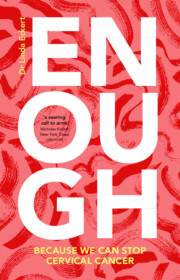Book contents
- Enough
- Reviews
- Enough
- Copyright page
- Dedication
- Contents
- Figures
- The Calling
- Part One A Preventable Cancer
- Part Two The Science behind Cervical Cancer
- Part Three The Prevention Problem
- 8 The Deadly Link between Inequality and Cervical Cancer
- 9 Losing the Life Lottery because of Where You Are Born
- 10 Sex, Lies, and Logistics: Obstacles to Vaccination beyond the Marketplace
- 11 Putting Out the Fires: Obstacles to Screening
- 12 “Dying Inside”: Obstacles to Treatment – and the Catastrophic Consequences
- 13 What Money Cannot Buy
- Part Four Getting to Enough
- Acknowledgments
- Reader Resources
- References
- Index
10 - Sex, Lies, and Logistics: Obstacles to Vaccination beyond the Marketplace
from Part Three - The Prevention Problem
Published online by Cambridge University Press: 11 January 2024
- Enough
- Reviews
- Enough
- Copyright page
- Dedication
- Contents
- Figures
- The Calling
- Part One A Preventable Cancer
- Part Two The Science behind Cervical Cancer
- Part Three The Prevention Problem
- 8 The Deadly Link between Inequality and Cervical Cancer
- 9 Losing the Life Lottery because of Where You Are Born
- 10 Sex, Lies, and Logistics: Obstacles to Vaccination beyond the Marketplace
- 11 Putting Out the Fires: Obstacles to Screening
- 12 “Dying Inside”: Obstacles to Treatment – and the Catastrophic Consequences
- 13 What Money Cannot Buy
- Part Four Getting to Enough
- Acknowledgments
- Reader Resources
- References
- Index
Summary
Misinformation and suspicion surrounding sexually transmitted HPV – along with the social implications of administering shots to young girls – significantly hinder worldwide uptake of the vaccine. The 2006 U.S. rollout hit a quagmire of public ignorance, suspicion and paranoia, and by 2020, just 61 percent of eligible U.S. girls had been vaccinated. In Japan, anti-vax sentiment led to an HPV vaccine ban, and in Denmark, the vaccine met similar resistance. Nearly twenty years after its introduction in higher-income countries, the vaccine is vastly behind its prevention potential; in lower-income countries, its trajectory has been abysmal. Hang-ups about sexually transmitted infections and baseless fears about the vaccine have made advocating its use a cause laden with stigma. In male-dominated cultures – and in the absence of an existing delivery system – a girls-only vaccine is often stopped before it can start. And yet, without a worldwide commitment to countering misunderstanding through trust-building, hundreds of thousands of women will miss their critical opportunity to beat this disease.
Keywords
- Type
- Chapter
- Information
- EnoughBecause We Can Stop Cervical Cancer, pp. 128 - 142Publisher: Cambridge University PressPrint publication year: 2024

